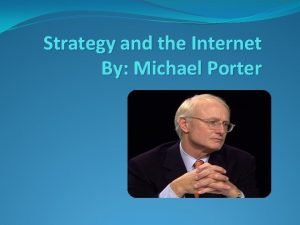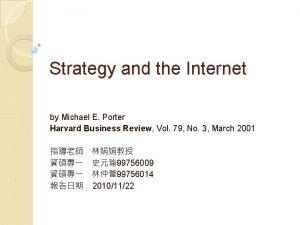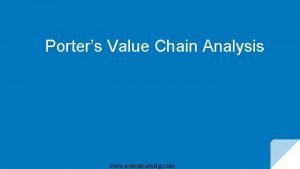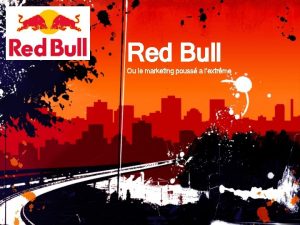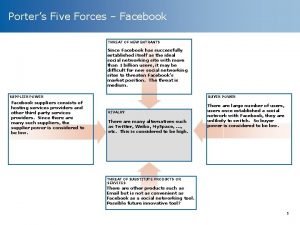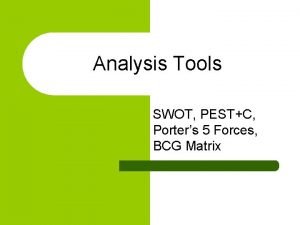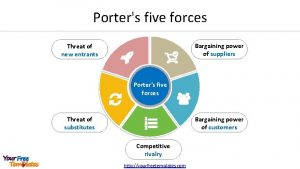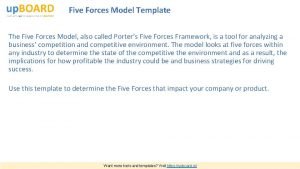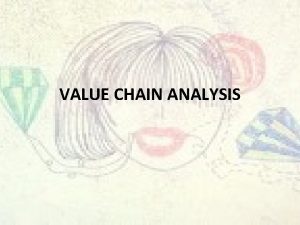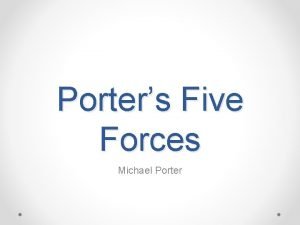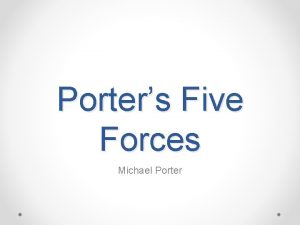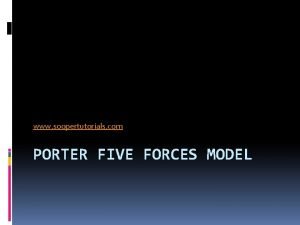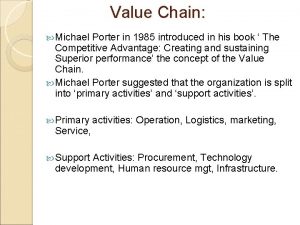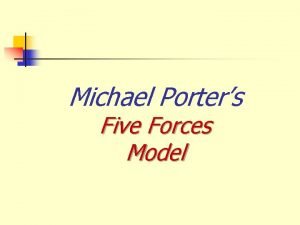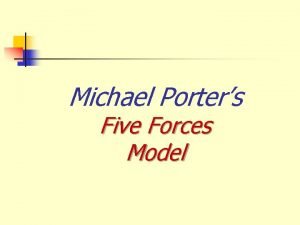Strategy via Michael Porter 5 Forces Value Chain












- Slides: 12

Strategy via Michael Porter 5 Forces Value Chain Competitive Advantage Richard Orwig 1

Porter’s Five Forces Model of Competitive Advantage • Porter’s Five Forces Model divides entities in the competitive landscape into 5 groups as follows: 1. Threat of New Entrants: new firms that may enter a companies market. 2. Bargaining Power of Buyers: the ability of buyers to use their market power to decrease a firm’s competitive position 3. Bargaining Power of Suppliers: the ability suppliers of the inputs of a product or service to lower a firm’s competitive position 4. Threat of Substitutes: providers of equivalent or superior alternative products 5. Industry Competitors: current competitors for the 2 same product.

5 Competitive Forces with Potential Strategic Use of Information Resources (Porter) 3

Application of 5 Forces Model Competitive Force IT Influence on Competitive Force Threat of New Entrant Can be lowered if there are barriers to entry. Sometimes IS can be used to create barriers to entry Can be high if it’s easy to switch. Switching costs are increased by giving buyers things they value in exchange such as lower costs or useful information Forces is strongest when there are few firms to choose from, quality is inputs is crucial or the volume of purchases is insignificant to the supplier Depends on buyers’ willingness to substitute and the level of switching costs buyer’s face Rivalry is high when it is expensive to leave and industry, the industry’s growth rate is declining, or products have lost differentiation Bargaining Power of Buyers Bargaining Power of Suppliers Threat of Substitute Products Industrial Competitors 4

Porter’s Value Chain Model • Porter’s Value Chain Model looks at increasing competitive advantage by reorganizing the activities related to create, support and deliver a firm’s product or service. • These activities can be divided into two broad categories (See Figure 2. 6): – Primary activities that relate directly to how value is created for a product or service. – Support activities that make the primary activities possible and that manage the coordinate of different activities. 5

Using Information Resources to Alter the Value Chain • The Value Chain model suggest that competition can come from two sources: – Lowering the cost to perform an activity (increase efficiency) and – Adding value to a product or service (increase effectiveness) so buyers will be willing to pay more or buy more often. • Lowering costs only achieves competitive advantage if the firm possesses information on the competitor’s costs • Adding value is a strategic advantage if a firm possesses accurate information regarding its customer such as: which products are valued? Where can improvements be made? 6

The Value System • The model can be extended by linking many value chains into a value system. • Much of the advantage of supply chain management comes from understanding how information is used within each value chain of the system. • This can lead to the formation of entire new businesses designed to change the information component of value-added activities. 7

Value Chain of the Firm 8

Types of Strategic Alliances • Supply Chain Management: technology, especially Web-based, allows the supply chain of a company’s customers and suppliers to be linked through a single network that optimizes costs and opportunities for all companies in the supply chain • Virtual Corporations: is a temporary network of suppliers, customer and even rivals linked by IT to share skills, cost and access to each others’ markets • Co-opetition: a strategy whereby companies cooperate and compete at the same time with companies in their value net 9

Porter’s Competitive Strategy Strategies for Achieving C. A 10

Porter’s Competitive Strategies • Cost leadership: be the cheapest • Differentiation: focus on making your product stand out for non-cost reasons • Focus: occupy narrow market niche where the products/services can stand out by virtue of their cost leadership or differentiation. 11

CAPSIM • What is your team’s competitive strategy? • How is that strategy working out for you? – “Stick to your knitting” meta-strategy – Random floundering meta-(un)strategy • Are you using Decision Making technology support? – To document your decision cycles – To analyze markets, trends, or operations 12
 Strategy and the internet porter
Strategy and the internet porter Strategy and the internet
Strategy and the internet Porter's value chain model
Porter's value chain model Porter’s generic strategies
Porter’s generic strategies Eltonian pyramid
Eltonian pyramid What is logistics management
What is logistics management Swot redbull
Swot redbull Porter's five forces example
Porter's five forces example Les 5 forces de porter
Les 5 forces de porter Costa coffee porter's five forces
Costa coffee porter's five forces Pest-c
Pest-c Bargaining power of customers
Bargaining power of customers Porter's five forces model template
Porter's five forces model template
